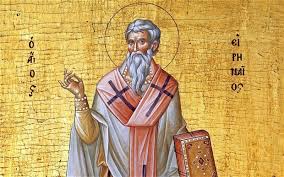(Saint Irenaeus of Lyons, whose feast we celebrate on the 28th of June, just before Saints Peter and Paul, was declared a Doctor of the Church by Pope Francis in 2022, bringing their exalted number to 37. Editor)
BENEDICT XVI
GENERAL AUDIENCE
St Peter’s Square
Wednesday, 28 March 2007
Saint Irenaeus of Lyons
Dear Brothers and Sisters,
In the Catechesis on the prominent figures of the early Church, today we come to the eminent personality of St Irenaeus of Lyons. The biographical information on him comes from his own testimony, handed down to us by Eusebius in his fifth book on Church History.
Irenaeus was in all probability born in Smyrna (today, Izmir in Turkey) in about 135-140, where in his youth, he attended the school of Bishop Polycarp, a disciple in his turn of the Apostle John. We do not know when he moved from Asia Minor to Gaul, but his move must have coincided with the first development of the Christian community in Lyons: here, in 177, we find Irenaeus listed in the college of presbyters. In that very year, he was sent to Rome bearing a letter from the community in Lyons to Pope Eleutherius. His mission to Rome saved Irenaeus from the persecution of Marcus Aurelius which took a toll of at least 48 martyrs, including the 90-year old Bishop Pontinus of Lyons, who died from ill-treatment in prison. Thus, on his return Irenaeus was appointed Bishop of the city. The new Pastor devoted himself without reserve to his episcopal ministry which ended in about 202-203, perhaps with martyrdom.
Irenaeus was first and foremost a man of faith and a Pastor. Like a good Pastor, he had a good sense of proportion, a wealth of doctrine, and missionary enthusiasm. As a writer, he pursued a twofold aim: to defend true doctrine from the attacks of heretics, and to explain the truth of the faith clearly. His two extant works – the five books of The Detection and Overthrow of the False Gnosis and Demonstration of the Apostolic Teaching (which can also be called the oldest “catechism of Christian doctrine”) – exactly corresponded with these aims. In short, Irenaeus can be defined as the champion in the fight against heresies. The second-century Church was threatened by the so-called Gnosis, a doctrine which affirmed that the faith taught in the Church was merely a symbolism for the simple who were unable to grasp difficult concepts; instead, the initiates, the intellectuals – Gnostics, they were called – claimed to understand what was behind these symbols and thus formed an elitist and intellectualist Christianity. Obviously, this intellectual Christianity became increasingly fragmented, splitting into different currents with ideas that were often bizarre and extravagant, yet attractive to many. One element these different currents had in common was “dualism”: they denied faith in the one God and Father of all, Creator and Saviour of man and of the world. To explain evil in the world, they affirmed the existence, besides the Good God, of a negative principle. This negative principle was supposed to have produced material things, matter.
Firmly rooted in the biblical doctrine of creation, Irenaeus refuted the Gnostic dualism and pessimism which debased corporeal realities. He decisively claimed the original holiness of matter, of the body, of the flesh no less than of the spirit. But his work went far beyond the confutation of heresy: in fact, one can say that he emerges as the first great Church theologian who created systematic theology; he himself speaks of the system of theology, that is, of the internal coherence of all faith. At the heart of his doctrine is the question of the “rule of faith” and its transmission. For Irenaeus, the “rule of faith” coincided in practice with the Apostles’ Creed, which gives us the key for interpreting the Gospel, for interpreting the Creed in light of the Gospel. The Creed, which is a sort of Gospel synthesis, helps us understand what it means and how we should read the Gospel itself.
(To continue reading, please see here)


